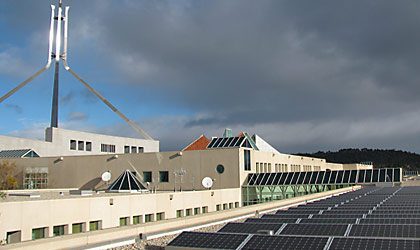The ACT government plans to bring another 650MW of renewable energy generation to its region following the successful completion of the second round of its solar auction.
The auction, which resulted in wins for China’s Zhenfa Solar with a 13MW plant, and for Australia’s Elementus Energy with a 7MW plant, means it’s hard to disagree with Simon Corbell’s boast that Canberra is the solar capital of the country.
Three of the five utility-scale solar arrays currently confirmed in Australia are based in Canberra. Apart from Zhenfa and Elementus, there is also the 20MW Royalla project, which won the first auction round. One other, the 10MW Greenough River plant in WA, has been completed, and the 155MW plant to be built by AGL Energy under the old solar flagships program will not be completed until late 2015.
However, given the ACT’s ambition to reach 90 per cent renewable energy generation by 2020, it could be that the territory becomes the focus of renewable energy development in Australia, particularly given the likelihood that the national renewable energy target will be diluted under a federal Coalition government.
The ACT government already has legislation in place to auction up to 210MW in renewable capacity, but in an interview on Monday with RenewEconomy in Canberra, Corbell said the government would soon reveal how it will reach the 690MW it needs to meet its 90 per cent renewables target.
There can be no doubting the success of the reverse auction process. Canberra has achieved, in a few years, what federal Labor has failed to do in more than six years of government. By the end of 2014, it will have two commercial-scale plants up and running – Royalla and Zhenfa’s Mugga Lane – and another nearly completed.
“We will see three large-scale solar farms up and operating here in the next two years,” Corbell says. “That’s a very significant outcome for a city of our size.
“What it does demonstrate is that other governments need to think again about some of the complex, lengthy and costly subsidy programs they have been running and consider a more flexible alternative.”
But is the auctioning process the way of the future? So far it has proved successful, and other countries are using it too. South Africa has had two rounds, allocating 1,194MW of solar PV capacity and more than 1,000MW of wind and solar thermal. This week it closed bidding for another 401MW of solar PV capacity. It is believed that more than 3,000MW of project proposals was bid into the scheme.
Corbell says that the ACT will review the results of the auctioning process before confirming the next move. The next rounds will look at projects beyond the borders of the ACT, and will extend into wind and waste-to-energy. Corbell says the government may even consider a feed-in tariff for storage.
The attraction of the auctioning systems is the certainty. At the federal level, a legislated fixed target of 41,000GWh renewable energy by 2020 has not produced the results intended because of a surplus of renewable energy certificates, and a high level of sovereign risk. Most developers and financiers are convinced that the target will be reduced by a Coalition government, and the Coalition are insisting that yet another review will be held next year.
(Recent reports in Fairfax newspapers have suggested there will be a $4 billion slump in finance for renewable energy projects should the Coalition get elected. But most published assessments suggests that this is less than half the damage that would be inflicted. Bloomberg New Energy Finance, for instance, recently estimated that reducing that target to a “real” 20 per cent target would result in a halving of investment to $12 billion).
Corbell says the 40MW of solar auctioned so far will cost households around 45c/week, although this would fall to 25c/household/week by 2020. Including energy efficiency measures, which Corbell says will cut bills by $300 a year, the total impact of the 90 per cent target would be a net benefit of $30 per household.
Ashleigh Antflick, the head of Elementus, says that while the auction system is working in Canberra, it would not necessarily be the most effective solution for the rest of Australia. That would depend on the size of projects, the geography, and the access to finance.
“There are barriers to big solar,” Antflick told RenewEconomy. “Some of them are financial, some of them are technical, and some of them are regulatory. But if you get rid of the regulatory barriers, then industry will likely be able to solve the other two.”










